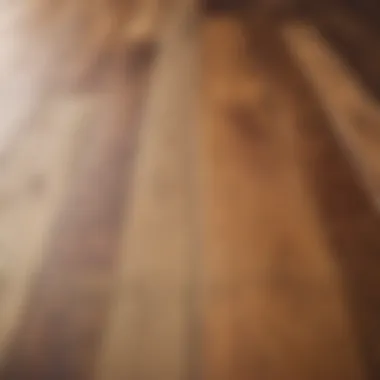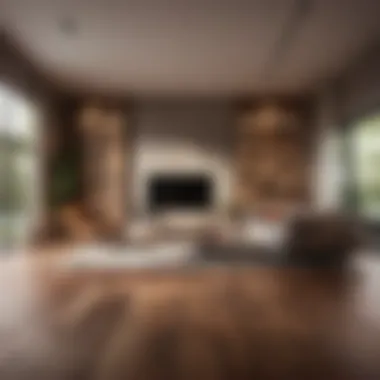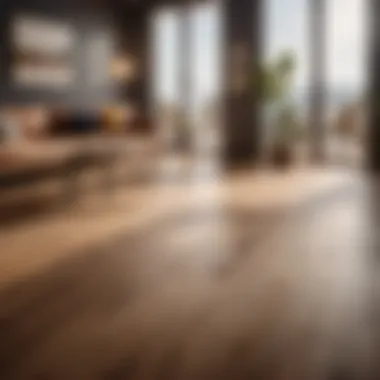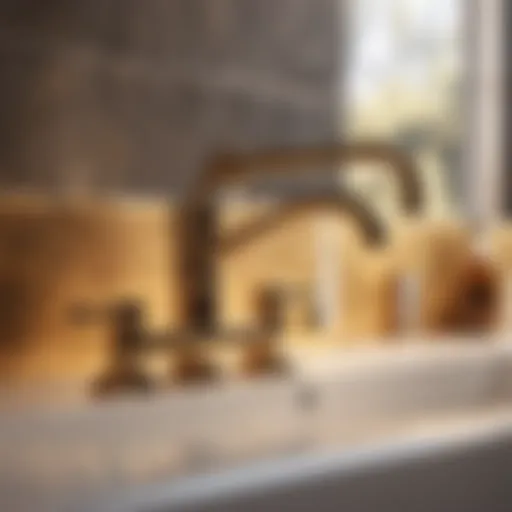Materials:
To embark on your engineered wood flooring project, it is essential to gather the following materials with precise measurements:
- Engineered wood flooring planks (quantity based on square footage)
- Underlayment material (appropriate thickness based on subfloor conditions)
- Flooring adhesive or nails
- Spacers for expansion gaps
- Moisture barrier
- Transition strips
- Tools required: tape measure, pencil, chalk line, circular saw, hammer, spacers, trowel, and protective gear such as gloves and goggles.
DIY Steps:
- Preparation: Ensure the subfloor is flat, clean, and dry. Acclimate the flooring planks in the room for at least 48 hours.
- Underlayment Installation: Lay down the underlayment material, staggering the seams and securing it properly.
- Starting Point: Begin laying the flooring from the longest and straightest wall, leaving expansion gaps around the edges.
- Plank Placement: Apply adhesive or nail down the first row of planks, ensuring they are snugly fit together.
- Continuation: Proceed to install subsequent rows, staggering the joints for structural integrity and aesthetics.
- Finishing Touches: Trim planks as needed to fit at the edges and complete the installation.
Technical Aspects:
- Timing: Plan for sufficient time to complete the installation, accounting for acclimatization and precision in placement.
- Tools: Each tool should be used as per manufacturer recommendations for optimal results.
- Techniques: Proper staggering of planks, ensuring correct adhesive application, and maintaining consistent expansion gaps are essential.
DIY Project Process:


Follow the sequential steps to ensure a successful installation:
- Aligning the First Row: Achieve a straight starting point for a professional finish.
- Adhesive Application: Apply an even layer of adhesive to ensure strong plank adhesion.
- Staggering Technique: Stagger end joints to provide a stable and visually appealing layout.
- Maintenance: Regularly clean and maintain the engineered wood flooring to preserve its beauty and longevity.
Troubleshooting Tips:


- Uneven Planks: Check the subfloor for levelness and make adjustments as necessary.
- Adhesive Issues: Ensure the adhesive is applied according to the manufacturer's guidelines to prevent bonding problems.
- Gap Inspection: Monitor expansion gaps to allow for natural wood movement without buckling.
Understanding Engineered Wood Flooring


In the realm of home improvement and interior design, understanding engineered wood flooring is paramount for making well-informed decisions. Engineered wood flooring stands out for its unique composition, which sets it apart from traditional solid wood flooring options. By exploring the composition, differences from solid wood flooring, and the benefits of engineered wood flooring, individuals can gain valuable insights to guide their purchasing journey.
Composition of Engineered Wood Flooring
Top Layer
The top layer of engineered wood flooring, also known as the wear layer, plays a crucial role in defining the floor's aesthetics and durability. Typically made of hardwood veneer, this layer determines the floor's appearance and resistance to wear and tear. Its primary advantage lies in offering a real wood look while enhancing durability and resistance to scratches and stains. Homeowners appreciate the natural beauty of hardwood without compromising on longevity.
Core Layer
The core layer serves as the foundation of engineered wood flooring, providing stability and moisture resistance. Composed of multiple layers of plywood or fiberboard, this layer enhances the floor's structural integrity. Its unique feature lies in its ability to withstand fluctuations in humidity levels, making it suitable for various environments. The core layer's advantage comes from its dimensional stability, ensuring the flooring remains flat and free from warping.
Bottom Layer
The bottom layer, also known as the backing or stabilizing layer, offers additional support and moisture resistance to engineered wood flooring. Constructed from plywood or composite material, this layer adds strength and durability to the overall structure. Its unique feature lies in enhancing the floor's resistance to moisture, making it suitable for areas prone to dampness. The bottom layer's advantage rests in providing a stable base for the entire flooring system, ensuring long-term performance.
Differences from Solid Wood Flooring
When compared to solid wood flooring, engineered wood flooring presents distinct advantages in terms of construction, durability, and moisture resistance. Understanding these differences is crucial for homeowners looking for a practical and long-lasting flooring solution.
Construction
The construction of engineered wood flooring involves layering different wood veneers to create a sturdy and resilient product. This innovative approach not only improves the flooring's strength but also enhances its ability to withstand temperature and humidity fluctuations. The key characteristic of this construction method is its engineered design, which maximizes durability while utilizing fewer natural resources compared to solid wood floors.
Durability
Engineered wood flooring excels in durability due to its layered construction, which offers enhanced resilience to impacts and environmental factors. The key characteristic lies in its ability to resist warping, shrinking, and expansion, making it ideal for high-traffic areas and regions with varying climatic conditions. Homeowners benefit from a long-lasting flooring solution that maintains its appearance and structural integrity over time.
Moisture Resistance
One of the standout features of engineered wood flooring is its superior moisture resistance compared to solid wood floors. The unique construction of engineered wood, including the core layer's moisture-resistant properties, allows it to withstand moisture-prone environments such as basements and kitchens. The key characteristic is its ability to combat structural damage caused by excess humidity, making it a practical choice for areas where traditional wood flooring may not thrive.
Benefits of Engineered Wood Flooring
The benefits of engineered wood flooring extend beyond traditional hardwood floors, offering homeowners a versatile, cost-effective, and environmentally friendly flooring option. Delving into these advantages can help individuals appreciate the value that engineered wood flooring brings to their homes.
Versatility
Engineered wood flooring excels in versatility, providing a wide range of design options to suit various interior styles and preferences. Whether homeowners prefer a classic oak finish or a contemporary distressed look, engineered wood offers diverse choices to complement any decor. The key characteristic of versatility lies in the myriad of wood species, colors, and finishes available, allowing for customizable flooring solutions to enhance any living space.
Cost-Efficiency
In terms of cost-efficiency, engineered wood flooring offers a budget-friendly alternative to solid hardwood floors without compromising on quality or aesthetics. Homeowners can enjoy the luxurious feel of real wood at a fraction of the cost, making it an attractive option for those seeking an affordable flooring solution. The key characteristic is its ability to mimic the appearance of solid wood while being more accessible in terms of pricing, making it a practical choice for budget-conscious individuals.
Environmental Impact
Environmental consciousness is a significant factor driving the popularity of engineered wood flooring among eco-conscious homeowners. With sustainable sourcing practices and efficient use of resources, engineered wood flooring minimizes its environmental impact while delivering a durable and elegant flooring solution. The key characteristic of environmental impact is its promotion of responsible forestry practices and reduced waste generation, aligning with the principles of sustainable living.
Factors to Consider Before Buying
Before diving into the world of engineered wood flooring, it is crucial to consider several key factors that will ultimately influence your purchase decision. By evaluating these elements thoughtfully, you can ensure a successful and satisfying outcome for your home renovation project. Factors such as room compatibility, budget allocation, and aesthetic preferences play a significant role in determining the most suitable option for your specific needs.
Room Compatibility
High-Traffic Areas
When considering engineered wood flooring for high-traffic areas in your home, such as entryways or living rooms, durability becomes a paramount factor. Engineered wood flooring is an excellent choice for these spaces due to its enhanced resilience against wear and tear caused by heavy foot traffic. Its multi-layered construction provides stability and resistance to dents and scratches, ensuring longevity in demanding environments.
Basements
Basements pose unique challenges when it comes to flooring, primarily due to potential moisture issues. Engineered wood flooring is a practical solution for basements as it offers better moisture resistance compared to solid wood flooring. The layered construction of engineered wood can withstand fluctuations in humidity levels, reducing the risk of warping or cupping. Its installation over concrete subfloors is straightforward, making it an ideal choice for basement renovations.
Kitchens
Kitchens demand flooring that can withstand spills, splashes, and heavy foot traffic while maintaining its integrity and beauty. Engineered wood flooring, with its moisture-resistant properties and durability, is an excellent option for kitchens. It provides a warm and inviting look without compromising on practicality. Additionally, its ease of cleaning makes it a popular choice for homeowners looking for a stylish yet functional flooring solution.
Budget Allocation
Cost per Square Foot
The cost per square foot is a crucial consideration when planning your flooring budget. Engineered wood flooring offers a range of price points depending on the wood species, finish, and quality. While it may have a higher initial cost than some alternatives, its durability and longevity make it a cost-effective investment in the long run. By carefully assessing the cost per square foot in relation to your budget and desired quality, you can make an informed decision that aligns with your financial goals.
Installation Costs
In addition to the cost of materials, installation costs play a significant role in your overall budget allocation. Professional installation of engineered wood flooring ensures a proper fit, minimizing potential issues down the line. While installation costs may vary based on factors such as room size and layout, investing in expert installation can enhance the performance and lifespan of your flooring, ultimately adding value to your home.
Additional Expenses
When budgeting for engineered wood flooring, it is essential to account for additional expenses beyond the initial purchase and installation. These may include underlayment, transition pieces, and finishing products. While these extras contribute to the overall cost, they are essential for achieving a seamless and polished look for your flooring. By foreseeing and budgeting for these additional expenses, you can prevent unexpected financial strain during the flooring installation process.
Aesthetic Preferences
Wood Species
The choice of wood species heavily influences the overall aesthetic of your space. Oak, walnut, and maple are popular options for engineered wood flooring, each offering unique grain patterns and colors. Oak is known for its durability and classic appeal, while walnut exudes richness and warmth. Maple, on the other hand, boasts a light and contemporary look. By selecting a wood species that complements your interior design style and personal taste, you can create a harmonious and visually pleasing ambiance in your home.
Color Options
Choosing the right color for your engineered wood flooring is a significant decision that impacts the overall atmosphere of your space. Whether you opt for natural wood tones, dark espresso hues, or modern grey finishes, the color of your flooring sets the foundation for your room’s design scheme. Lighter shades can make a room feel more open and airy, while darker tones add a sense of sophistication and coziness. By considering your existing decor and desired mood, you can select a color that enhances the aesthetic appeal of your home.
Surface Finish
The surface finish of engineered wood flooring affects both its appearance and durability. Matte finishes offer a more natural and rustic look, hiding scratches and imperfections effectively. Gloss finishes, on the other hand, provide a sleek and reflective surface that adds a touch of elegance to any room. Distressed finishes create a weathered and vintage charm, perfect for creating a cozy and lived-in feel. By choosing a surface finish that aligns with your style preferences and practical needs, you can achieve a cohesive and visually appealing look throughout your living spaces.
Choosing the Right Material
When embarking on the journey of selecting the ideal material for your engineered wood flooring, it is crucial to delve into the nuances of each option to make an informed decision. The material you choose will not only impact the aesthetics of your space but also its durability and performance over time. By understanding the specific elements, benefits, and considerations related to choosing the right material for your flooring, you can ensure a successful and satisfying outcome.
Wood Species
When considering the wood species for your engineered wood flooring, options such as Oak, Walnut, and Maple stand out as popular choices, each with its unique characteristics and advantages.
Oak
Oak is renowned for its classic and timeless appearance, with distinctive grain patterns that add warmth and elegance to any room. Its excellent durability and resistance to wear make it a popular choice for high-traffic areas, ensuring longevity and a timeless appeal. Although Oak tends to be slightly more expensive than other options, its resilience and aesthetic appeal make it a worthwhile investment for those seeking quality and longevity in their flooring.
Walnut
Walnut exudes a rich, luxurious look with deep, dark tones that lend a sense of sophistication to any space. Its unique grain patterns and varying color shades create a visually striking floor that stands out for its beauty and character. While Walnut is a softer wood compared to Oak, it offers a distinct visual appeal that complements both traditional and modern interior designs. However, its softer nature may require more maintenance to preserve its pristine appearance over time.
Maple
Maple is prized for its light, uniform appearance and smooth texture, adding a sense of brightness and openness to rooms. Its versatility in taking stains and finishes makes it a customizable option for homeowners looking to achieve a specific aesthetic. Maple’s natural resistance to moisture makes it an ideal choice for kitchens and bathrooms, providing both beauty and functionality. However, its lighter color may show scratches and dents more prominently compared to darker wood species.
By exploring the characteristics, advantages, and potential drawbacks of Oak, Walnut, and Maple, you can make an informed decision based on your preferences, budget, and desired aesthetic outcome.
Installation Tips and Techniques
Acclimation Process
Time Frame
Discussing the Time Frame aspect is crucial in the context of the acclimation process for engineered wood flooring. The specific duration required for acclimation plays a pivotal role in ensuring the stability and longevity of the flooring once installed. By highlighting the recommended time frames for acclimation based on the manufacturer's guidelines and environmental factors, readers can understand the significance of allowing the flooring material to adjust to its surroundings properly. This practice is beneficial as it aids in minimizing issues related to expansion or contraction post-installation, ultimately enhancing the overall performance and appearance of the flooring.
Humidity Levels
Exploring the impact of Humidity Levels during the acclimation process is paramount in achieving optimal flooring outcomes. Understanding the importance of maintaining balanced humidity levels within the installation environment is crucial for preventing potential warping, buckling, or gaps in the flooring. By emphasizing the ideal humidity range and methods to control moisture levels effectively, readers can grasp the essential role that humidity plays in ensuring the durability and stability of engineered wood flooring over time.
Preparation Steps
Detailing the necessary Preparation Steps for installing engineered wood flooring is vital for a successful and long-lasting outcome. From subfloor assessment to moisture testing and ensuring the space is clean and debris-free, each preparation step contributes to the overall quality of the installation. By discussing the importance of meticulous preparation and detailing the specific actions required before laying the flooring, readers can appreciate the significance of thorough planning and execution in achieving a flawless end result.
Floating vs. Glue-Down Installation
In the decision between Floating and Glue-Down Installation methods for engineered wood flooring, understanding the Pros and Cons of each approach is essential. By evaluating factors such as ease of installation, stability, and flexibility, readers can make an informed choice based on their specific requirements and preferences. Highlighting the benefits of each method alongside their drawbacks provides readers with a comprehensive overview, empowering them to select the most suitable installation technique for their particular needs.
Pros and Cons
Analyzing the Pros and Cons of Floating vs. Glue-Down Installation delves into the advantages and limitations of each method. From ease of repair and cost-effectiveness to long-term durability and moisture resistance, each aspect contributes to the overall suitability of the installation technique. By elucidating the unique features of both methods and discussing how they align with the goals of the flooring project, readers can make a well-informed decision that aligns with their desired outcome.
Suitable Environments
Exploring the notion of Suitable Environments for Floating vs. Glue-Down Installation sheds light on the environmental considerations that impact the choice of installation method. Factors such as room usage, subfloor conditions, and moisture levels play a crucial role in determining the most suitable approach. By outlining the ideal environments for each method and addressing any limitations based on specific conditions, readers can identify the optimal installation technique that best suits their space and lifestyle.
Recommended Tools
Highlighting the importance of Recommended Tools for engineered wood flooring installation emphasizes the necessity of using the right equipment for a successful project. From basic tools such as tape measures and saws to specialized tools like moisture meters and tapping blocks, having the correct tools on hand can streamline the installation process and ensure precision and efficiency. By providing insights into the key tools required for both Floating and Glue-Down Installation methods, readers can prepare adequately and execute the installation with confidence and accuracy.
Professional Installation Considerations
When considering professional installation for engineered wood flooring, factors such as Certified Installers, Warranty Coverage, and Post-Installation Inspection are paramount. Engaging certified professionals ensures the quality and expertise needed to execute a flawless flooring installation. Exploring warranty coverage and post-installation inspection procedures adds an extra layer of protection and reassurance for homeowners, guaranteeing a satisfactory outcome and long-term satisfaction with their investment.
Maintenance and Care Guidelines
In the realm of Engineered Wood Flooring, maintaining and caring for your floors is paramount to ensure longevity and beauty in your living space. Understanding the nuances of Maintenance and Care Guidelines plays a vital role in preserving the quality and aesthetics of your flooring investment. By adhering to proper maintenance protocols, you can prolong the lifespan of your engineered wood floors and keep them looking pristine for years to come.
Regular Cleaning Practices
Maintaining the cleanliness of your engineered wood flooring begins with regular cleaning practices. Sweeping and Vacuuming serve as the essential foundation for keeping your floors free from dust, dirt, and debris, preventing scratches and maintaining a polished appearance. Incorporating this routine cleaning regimen not only enhances the overall look of your space but also contributes to the longevity of your flooring investment. However, it's essential to use soft-bristled brooms or vacuum attachments to avoid any potential damage to the wood surface.
Damp Mopping is another pivotal aspect of regular cleaning practices, offering a deeper level of cleaning to eliminate stubborn stains and grime. Utilizing a damp (not wet) mop with a gentle cleanser specifically formulated for engineered wood floors can effectively remove dirt without causing harm to the flooring finish. This method provides a thorough cleaning solution while safeguarding your floors against unnecessary water exposure.
When it comes to maintenance, Avoiding Harsh Chemicals is crucial to preserving the integrity of your engineered wood flooring. Harsh chemicals can strip away the protective layers of the wood, leading to discoloration and damage over time. Opting for mild, pH-neutral cleaners designed for engineered wood floors ensures a gentle yet effective cleaning routine without compromising the natural beauty of the wood.
Preventive Maintenance Tips
Beyond regular cleaning practices, implementing preventive maintenance measures is key to safeguarding your engineered wood flooring investment against wear and tear. Furniture Protectors offer a simple yet effective solution to prevent scratches and dents caused by heavy furniture. Felt pads or rubber caps placed under furniture legs create a protective barrier between the furniture and the floor, minimizing the risk of damage.
Integrating Area Rugs strategically throughout your space not only enhances the visual appeal but also acts as a shield against high-traffic areas and furniture movement. By placing area rugs in key zones, you can reduce the direct impact on your engineered wood floors, prolonging their pristine condition and longevity.
Avoiding Water Damage is paramount in the realm of preventive maintenance. Water spills, leaks, or excess moisture can penetrate the wood layers, leading to warping, cupping, and discoloration. Promptly addressing any spills and ensuring proper ventilation in moisture-prone areas can mitigate the risk of water damage and preserve the structural integrity of your engineered wood floors.
Refinishing and Restoration Options
While maintenance and preventive measures play a crucial role in caring for your engineered wood flooring, there may come a time when refinishing or restoration is necessary to revive the luster and appeal of your floors. Sanding and Refinishing is a popular method to rejuvenate worn-out or damaged wood surfaces, removing scratches, stains, and imperfections to reveal a fresh layer of wood underneath. This process not only restores the original beauty of your floors but also extends their lifespan.
Spot Repairs offer targeted solutions for localized damage, such as scratches, dents, or minor discoloration. By addressing these imperfections promptly with specialized repair kits or professional services, you can prevent further deterioration and maintain the flawless appearance of your engineered wood flooring.
In cases where comprehensive restoration is required, Professional Refinishing Services provide expert solutions to transform your aging floors into like-new condition. Professional refinishing involves sanding, staining, and sealing your floors with precision and expertise, ensuring a seamless finish that revitalizes the aesthetic appeal of your living space.





